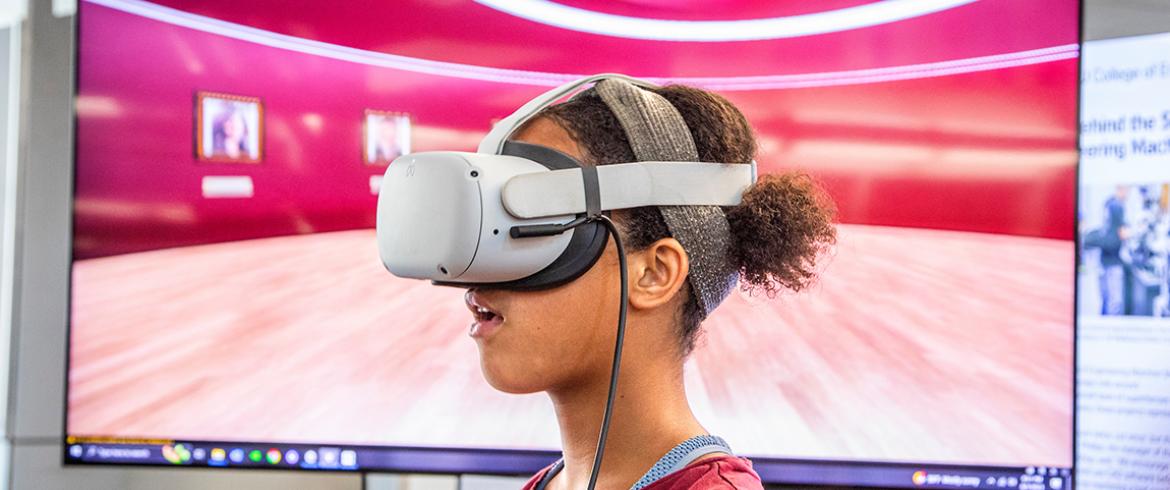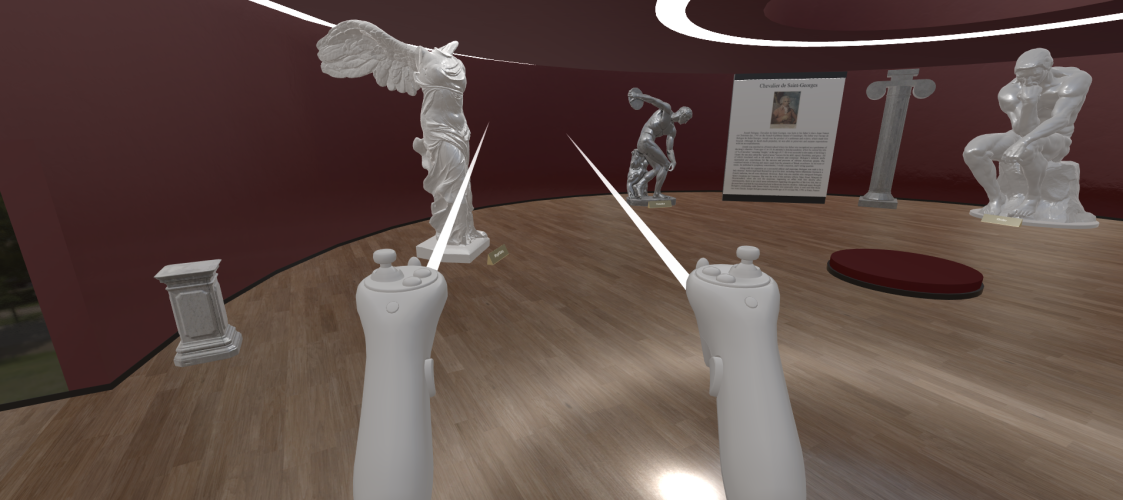
One of the attendees looks through an oculus to tour the Virtual AI Museum during the grand opening at the FAMU-FSU College of Engineering. (M Wallheiser/FAMU-FSU Engineering)
The grand opening of the FAMU-FSU College of Engineering Virtual AI Art Museum brought folks across the community, including local leaders, faculty, and administrators, together with students to see how artificial intelligence or AI is affecting our lives in ways we may not have imagined.
“We wanted everyone to have fun, be entertained and feel special, so our students suggested a gala, complete with a red carpet,” Shonda Bernadin, an associate professor in electrical and computer engineering, said. “It’s also about generating discussion and getting people to talk about AI and discuss how it may impact the community in the future.”
Bernadin organized the event to highlight her students’ summer research. The students worked together for 10 weeks to build a virtual art museum and worked on related projects to demonstrate the power of generative AI.
“I think we are doing some amazing things that are exciting and innovative at the FAMU-FSU College of Engineering,” Bernadin said. “College students and high school apprentices created many projects featured at this event, and I’m overwhelmed by the creativeness and work ethic of what our students accomplished.”
Bernadin is the creator and director of the Academic and Career Excellence in Engineering (ACEE) and the ECE Mentoring Program, a joint program that engages students from the high school level to graduate school. The participants investigated several generative AI tools like ChatGPT, DALL-E, Midjourney, and technology commonly used to create manipulated or synthesized digital media content.
“This is one of the very few programs structured with three-layer mentorship,” Tejal Mulay, a visiting professor at FAMU and faculty coordinator, said. “Our graduate students mentored the undergraduates who, in turn, mentored the high school apprentices. Twenty students participated, and Dr. Bernadin supervised the entire project.”
Migara Amarasinghe, a graduate mentor and a doctoral candidate in electrical and computer engineering, was incredibly enthusiastic about the collaboration of art and engineering with the virtual museum said, “Everyone wanted to join the project because it is such a cool idea, and brought together artists, musicians, and engineers and involved the FAMU and FSU main campuses.”
Sarah Mason, an undergraduate in studio art at FSU, said, “I worked with some of the high school students who drew the artwork for the museum and found historical assets for some of the virtual rooms in the project. I have never worked with engineering before, and it was exciting to collaborate in this way.”
Armarasinghe, who led the AI museum project, explained, “We also collaborated with the FSU music department, and they created original music for the virtual rooms in the museum. We have three separate rooms, one featuring African art, one with sculptures, and another with Marvel and Star Wars. Walking in, you will hear original themed music they produced specifically for the project.”
Several displays showcased how we can use AI tools and algorithms in the future. Alex, a high school student, said he created a VR educational game using ChatGPT.
“I did this project without any programming; I just asked a few questions and ChatGPT gave me the code,” he said.
Other students produced a 3-D holograph project, a museum figurine project involving 3-D printing and several generative AI videos. One display showed how AI could misinterpret the images of iconic Black women like Oprah Winfrey and Michelle Obama. The video illustrates the social implications of the technology.
AI impacts our world both good and bad and, as Bernadin sees it, the FAMU-FSU College of Engineering is the place to discover how we want to use AI and have that conversation.
“I hosted this event to bring awareness to AI,” Bernadin said. “It’s changing how we interact with each other, the world and ourselves. I want to cultivate conversation, and if we want to be leaders and contributors to AI, then we need to start the conversation. We are a model, a hub, for what the future will bring.”
If you are interested in being part of the conversation and would like more information about the program and how AI is transforming your community, please contact Shonda Bernadin, Ph.D. or Korie Mitchell.
ECE Research Mentoring participants and ACEE High School Apprentices involved in the work:
- Migara Amarasinghe, PhD candidate
- Fasih Waheed, PhD candidate
- Naela Luna, Undergraduate
- Sarah Mason, Undergraduate
- William Bernadin, HS Apprentice
- Onyinye Okoli, HS Apprentice
- Chinonso Okoli, HS Apprentice
- Destin Tucker-German, HS Apprentice
- Elijah Palmer, HS Apprentice
- Chidalu Abanah, HS Apprentice
- Alex Wang, HS Apprentice

RELATED ARTICLES
Researchers Use Artificial Intelligence to Analyze Human Work Performance
John Ensor Parker, Engineer and Artist, Shares His Journey as a Creator
